
views
Active Sentences
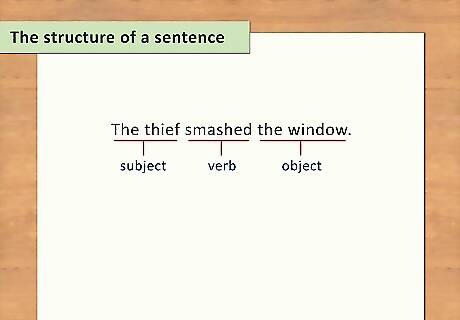
Try out this example first. Look at this sentence: "The thief smashed the window." The red section, "The thief," is the subject of the sentence, or the one doing the action. The purple section, "smashed," is the verb, or action. The blue section, "the window," is the object: something is happening to it. Keep reading for more explanation, and look back at this example sentence to follow along.

Understand the subject of an active sentence. In an active sentence, the subject is whatever does something. It can be a person, a place, a thing, or even an idea. Here are some examples, with the subject in red: Every morning, the sun rises. The tall woman will brush her teeth. Your bravery saved the town.

Find the verbs in active sentences. In active sentences, the verb describes what the subject does. It can also describe what the subject did in the past, or will do in the future. Here are some examples, with the verb colored purple: The tree grew very tall. My enemy is planning his attack.

Learn about the object of the sentence. In many active sentence, but not all of them, an action is done to something else. Here are examples, with the object colored blue: The dog ate the meat. The explorers discovered a new river.
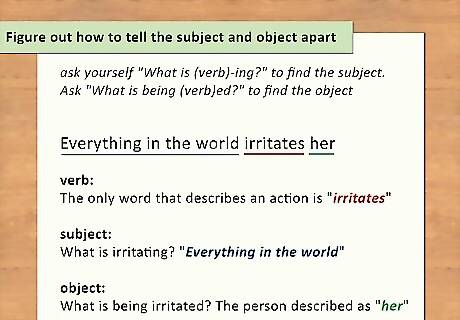
Figure out how to tell the subject and object apart. If you're not sure whether something is the subject or object, find yourself the verb and ask yourself "What is (verb)-ing?" to find the subject. Ask "What is being (verb)ed?" to find the object. Here's an example of a tricky sentence, step by step: "Everything in the world irritates her." Find the verb. The only word that describes an action is "irritates", so "irritates" must be the verb. Find the subject. What is irritating? "Everything in the world" is irritating, so the entire phrase "Everything in the world" is the subject. Find the object. What is being irritated? The person described as "her" is being irritated, so "her" is the object.
Passive Sentences

Look at this example. "The ball is thrown by the athlete." In this passive sentence, the subject is "The ball". The verb, "was thrown", describes what happened to the ball. The agent, the thing that did the action, is "the athlete".
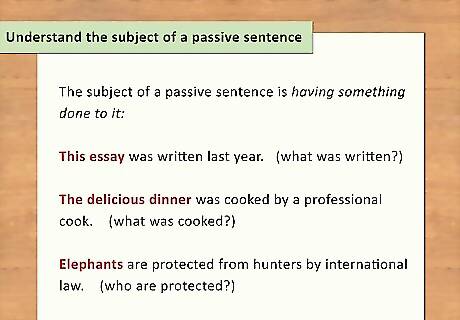
Understand the subject of a passive sentence. The subject of a passive sentence is having something done to it. This can be any noun: a person, place, thing, or idea. Here are some examples, with the subject written in red: This essay was written last year. The delicious dinner was cooked by a professional cook. Elephants are protected from hunters by international law.
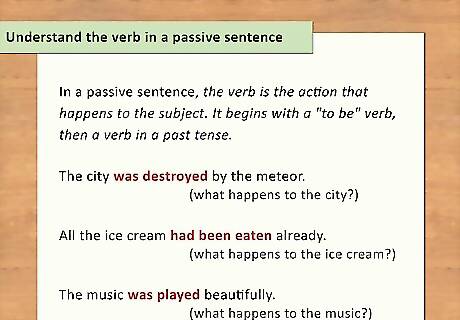
Understand the verb in a passive sentence. In a passive sentence, something happens to the subject. The verb is the action that happens. It begins with a "to be" verb (for example, "is," "was," "were," "has been," "will have been"), then a verb in a past tense. Here are some examples with the verb colored purple: The city was destroyed by the meteor. All the ice cream had been eaten already. The music was played beautifully.
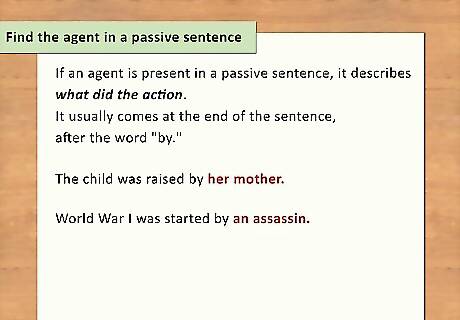
Find the agent in a passive sentence. Many passive sentences do not include the agent at all. If an agent is present, it describes what did the action. It usually comes at the end of the sentence, after the word "by." Here are some examples, with the agent colored brown: The child was raised by her mother. World War I was started by an assassin.
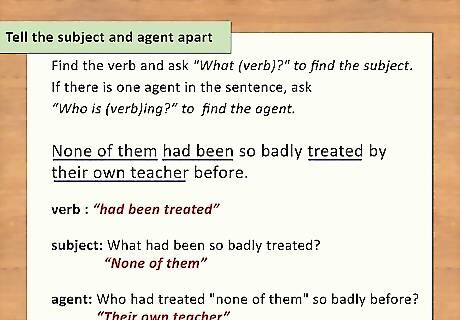
Tell the subject and agent apart. Remember, a passive sentence is about a subject that something is happening to. Find the verb and ask "What (verb)?" to find the subject. To find the agent, if there is one in the sentence, rephrase the sentence to ask "Who is (verb)ing? Here's a difficult example, step by step: "None of them had been so badly treated by their own teacher before." Find the passive verb. This sentence might sound confusing because the writer has added some adverbs in the middle of the verb! The full verb is "had been (...) treated". If it makes the sentence easier to follow, you can treat the verb as "had been so badly treated." Find the subject. What had been so badly treated? None of them had been so badly treated. "None of them" is the subject of the sentence. Find the agent. Who had treated "none of them" so badly before? Their own teacher had treated "none of them" so badly before. "Their own teacher" is the agent of the passive sentence.
Telling Them Apart
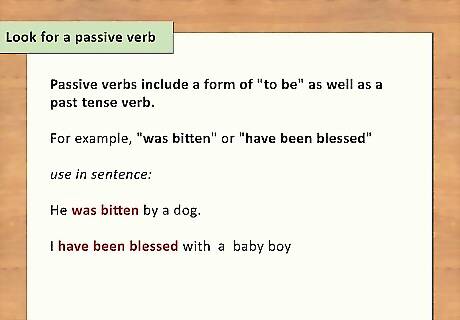
Look for a passive verb. Passive verbs include a form of "to be" as well as a past tense verb. For example, "was bitten" or "been blessed." This is one of the easiest ways to tell a passive sentence apart, but the next step is also useful for figuring out difficult sentences, and becoming familiar with how passive and active sentences work.
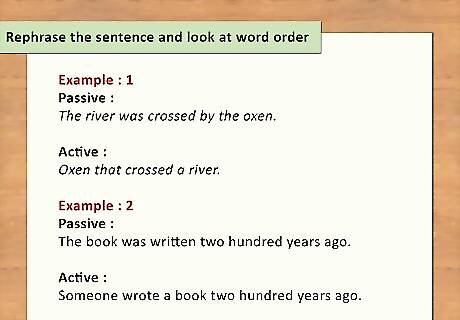
Rephrase the sentence and look at word order. Read the sentence, think about what it means, and try to describe the topic as an active sentence: "someone that did something." If the order of words is the same as the original sentence, the sentence is active. If you had to change the order, the sentence is probably passive. Here are some examples: "The flower bloomed every night." This sentence is about "a flower that bloomed." You didn't have to change the sentence to say that, so it's an active sentence. "The river was crossed by the oxen. This sentence is about "oxen that crossed a river." You had to change the order of the nouns (river and oxen), so the original sentence is passive. "The book was written two hundred years ago." This sentence is about "Someone that wrote a book." You had to add a whole new noun (someone) to guess who did the writing! The original sentence is definitely passive.
When to Use Active Versus Passive
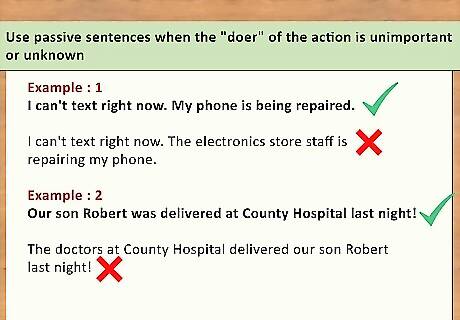
Use passive sentences when the "doer" of the action is unimportant or unknown. For example, "This cave painting was created thousands of years ago." is a good passive sentence. It focuses the attention right on what you want to talk about, the cave painting. The active version of this sentence "Someone created this cave painting thousands of years ago," adds unnecessary words (someone) and makes the topic of the sentence ("this cave painting") harder to find. Here are additional examples: "I can't text right now. My phone is being repaired." is more useful than "I can't text right now. The electronics store staff is repairing my phone." "Our son Robert was delivered at County Hospital last night!" tells your family the news it wants to hear right away. "The doctors at County Hospital delivered our son Robert last night!" puts the focus on the doctors, whom Uncle Joe probably doesn't care about.
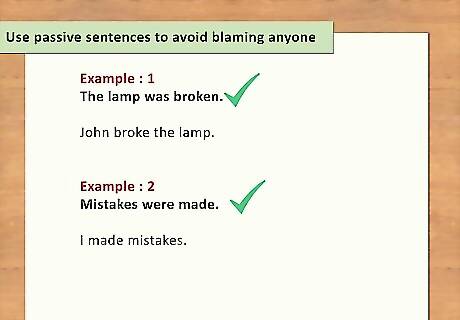
Use passive sentences to avoid blaming anyone. If someone did something embarrassing, you can use a passive verb to avoid calling attention to him. For example, say "The lamp was broken." instead of "John broke the lamp" if you want to tell everyone that you need a new lamp, without making John feel bad. (Even the active sentence "Someone broke the lamp" may start an argument over who did it.) This use comes up often in politics and news announcements. Keep an eye out for a celebrity, politician, or company spokesman that says "Mistakes were made." so they can avoid admitting that "I made mistakes."
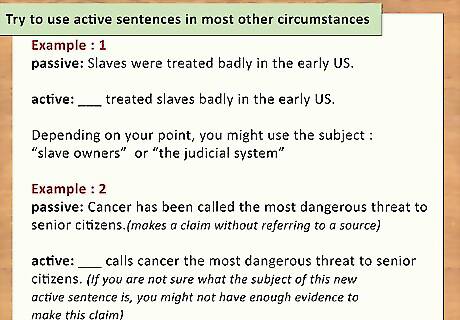
Try to use active sentences in most other circumstances. In most cases, an active verb makes a sentence more forceful and easier to follow. When you write a passive sentence, stop and try to rewrite it as an active sentence. It's not always necessary, but it often forces you to improve your writing and think harder about what you're trying to say. For example: "Slaves were treated badly in the early US." can be rewritten as "___ treated slaves badly in the early US." Depending on your point, you might use the subject "slave owners," "the judicial system," or one of many other nouns. "Cancer has been called the most dangerous threat to senior citizens." makes a claim without referring to a source. Rewrite this as "___ calls cancer the most dangerous threat to senior citizens." If you are not sure what the subject of this new active sentence is, you might not have enough evidence to make this claim.















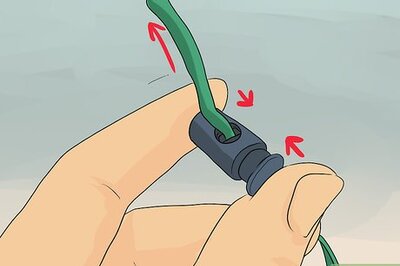

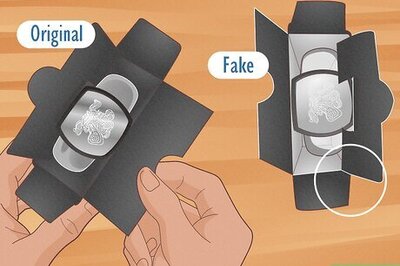

Comments
0 comment